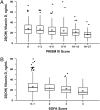Vitamin D deficiency in critically ill children
- PMID: 22869836
- PMCID: PMC4074622
- DOI: 10.1542/peds.2011-3328
Vitamin D deficiency in critically ill children
Abstract
Objective: Vitamin D influences cardiovascular and immune function. We aimed to establish the prevalence of vitamin D deficiency in critically ill children and identify factors influencing admission 25-hydroxy vitamin D (25(OH)D) levels. We hypothesized that levels would be lower with increased illness severity and in children with serious infections.
Methods: Participants were 511 severely or critically ill children admitted to the PICU from November 2009 to November 2010. Blood was collected near PICU admission and analyzed for 25(OH)D concentration by using Diasorin radioimmunoassay.
Results: We enrolled 511 of 818 (62.5%) eligible children. The median 25(OH)D level was 22.5 ng/mL; 40.1% were 25(OH)D deficient (level <20 ng/mL). In multivariate analysis, age and race were associated with 25(OH)D deficiency; summer season, vitamin D supplementation, and formula intake were protective; 25(OH)D levels were not lower in the 238 children (46.6%) admitted with a life-threatening infection, unless they had septic shock (n = 51, 10.0%) (median 25(OH)D level 19.2 ng/mL; P = .0008). After adjusting for factors associated with deficiency, lower levels were associated with higher admission day illness severity (odds ratio 1.19 for a 1-quartile increase in Pediatric Risk of Mortality III score per 5 ng/mL decrease in 25(OH)D, 95% confidence interval 1.10-1.28; P < .0001).
Conclusions: We found a high rate of vitamin D deficiency in critically ill children. Given the roles of vitamin D in bone development and immunity, we recommend screening of those critically ill children with risk factors for vitamin D deficiency and implementation of effective repletion strategies.
Figures

Comment in
-
Vitamin D deficiency in critically ill children: a roadmap to interventional research.Pediatrics. 2012 Sep;130(3):557-8. doi: 10.1542/peds.2012-1752. Epub 2012 Aug 6. Pediatrics. 2012. PMID: 22869827 No abstract available.
References
-
- Misra M, Pacaud D, Petryk A, Collett-Solberg PF, Kappy M, Drug and Therapeutics Committee of the Lawson Wilkins Pediatric Endocrine Society . Vitamin D deficiency in children and its management: review of current knowledge and recommendations. Pediatrics. 2008;122(2):398–417 - PubMed
-
- Van den Berghe G, Van Roosbroeck D, Vanhove P, Wouters PJ, De Pourcq L, Bouillon R. Bone turnover in prolonged critical illness: effect of vitamin D. J Clin Endocrinol Metab. 2003;88(10):4623–4632 - PubMed
-
- Wagner CL, Greer FR, American Academy of Pediatrics Section on Breastfeeding. American Academy of Pediatrics Committee on Nutrition . Prevention of rickets and vitamin D deficiency in infants, children, and adolescents. Pediatrics. 2008;122(5):1142–1152 - PubMed
Publication types
MeSH terms
Substances
Grants and funding
LinkOut - more resources
Full Text Sources
Medical

